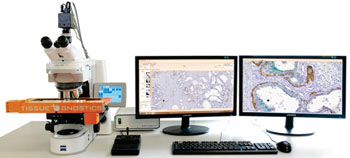New Technology Developed to Diagnose Cancer Cells
By LabMedica International staff writers
Posted on 04 Aug 2014
Patient tumors can be analyzed for aberrant activations of core cancer pathways by monitoring based on biomarker expression which ensures efficient treatment in targeted therapy.Posted on 04 Aug 2014
Standard evaluation of cancer specimen by immunohistochemistry is frequently impeded by its dependence on subjective interpretation, showing considerable intra- and inter-observer variability and the certainty of the diagnosis depends greatly on the individual pathologist.

Image: Microscopic analysis system automatically acquires up to eight slides with immunohistochemically stained sections and performs quantitative analysis of staining intensities (Photo courtesy of TissueGnostics).
Scientists at the Medical University of Vienna (Austria) working with their colleagues from other institutes, used both human liver specimens and a mouse model to test quantitative image analysis tools. They used immunohistochemistry to identify deletion of the transcription factors Signal Transducer and Activator of Transcription 5 (Stat5ab) in the liver as well Transcription factor jun-B (Junb) deletion in a T-cell lymphoma model. They quantified the expression of total or activated STAT5AB or JUNB protein by Western Blots and detection was accomplished using an electrochemiluminescence detection system (Amersham Biotech; Amersham, UK).
The technology-platform of TissueGnostics GmbH (Vienna, Austria) provides tools to quantify protein expression levels on immunohistochemically stained tissue slides or cell preparations using the company’s proprietary HistoQuest. The software programs are based on single cell detection by identification of nuclear structures. The software uses certain algorithms and highly sensitive digital photography, enabling it to represent the matrix of cells and the cell nucleus better than under the microscope. STAT5 plays an important role in the development of leukemia and liver cancer. The JUNB gene is involved in the development of tumors in lymph gland tissue.
Nuclear signals were distinguished from cytoplasmic expression and translocation of the transcription factors from the cytoplasm to the nucleus and were reliably detected and quantified using image analysis. The investigators demonstrated that image analysis supported pathologists to score nuclear STAT5AB expression levels in immunohistologically stained human hepatocellular patient samples and decreased inter-observer variability. The scientists investigated and analyzed 30 liver cell carcinomas and were able to classify them into categories ranging from "negative" to "strongly positive" using the software.
Lukas Kenner MD, the senior author of the study, said, “The new program of course does not make pathologists redundant, however it is a supplementary method that considerably increases diagnostic certainty. Cancer therapies are expensive. This new software will also help us to assess more effectively where expensive therapy is justified, but also which cases do not need it, thereby also sparing the patient.” The study was published on July 11, 2014, in the journal Public Library of Science ONE.
Related Links:
Medical University of Vienna
Amersham Biotech
TissueGnostics












.jpg)
